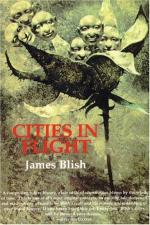|
This section contains 295 words (approx. 1 page at 300 words per page) |

|
Viewed as a work concerned with the future destruction of Western civilization, Cities in Flight is part of a long tradition. Stories touching on the political collapse of the United States have, of course, been common since the midnineteenth century, if not earlier.
Among the most important immediate predecessors of Blish's work would be Sinclair Lewis's It Can't Happen Here (1935), Robert A. Heinlein's Sixth Column (1941), and Fritz Leiber's Gather, Darkness! (1943). Science fiction stories which projected the worst aspects of Cold-War America into the future were extremely common in the 1950s.
Among many such works might be noted Judith Merril's much underrated Shadow on the Hearth (1950), Fritz Leiber's "Coming Attraction" (1951), Ray Bradbury's Fahrenheit 451 (1953), and Frederik Pohl and C. M. Kornbluth's The Space Merchants (1953). Although Blish published primarily in Campbell's Astounding Science Fiction, throughout the 1950s Galaxy Science Fiction, edited by H. L. Gold, published stories about the...
|
This section contains 295 words (approx. 1 page at 300 words per page) |

|




